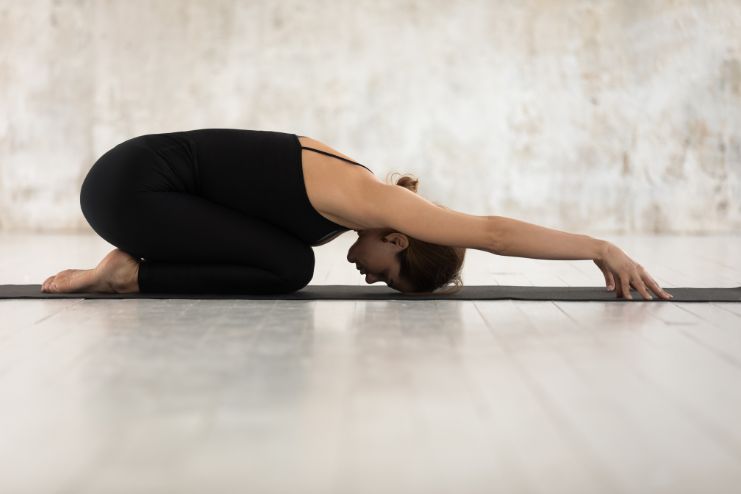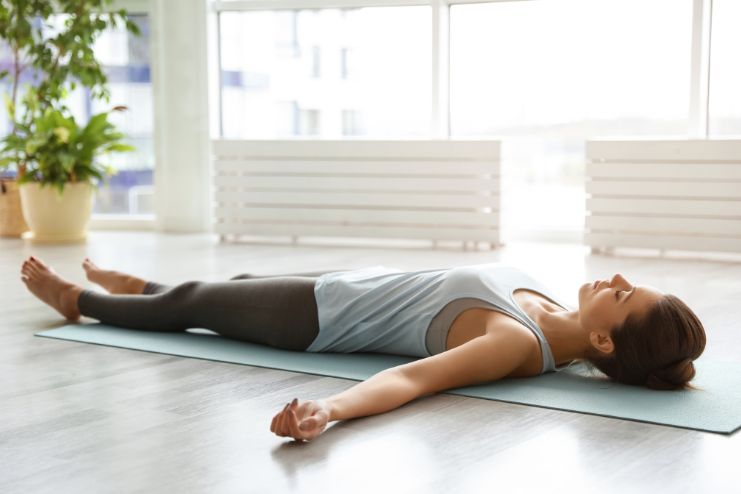Your body longs for rest after a demanding day of work, exertion, and stress. Stretching is a quick and easy way to relax your body and mind before bed. It eases stiffness, relieves accumulated muscle tension, and prepares your body for a good night’s sleep.
One of the main advantages of stretching at night is improving sleep quality. Gentle stretching stimulates the parasympathetic nervous system, which lowers stress chemicals like cortisol and decreases the heart rate. Consequentially, you get more profound, rejuvenating sleep.
Regular stretching also improves mobility and flexibility, avoiding muscle soreness and tightness. A few minutes of focused stretching may improve your posture, back discomfort, and overall body stiffness.
This article will cover the most significant evening stretches that encourage relaxation, enhance circulation, and facilitate falling asleep. Let’s begin!
Read More: Daily Stretching Exercises for Flexibility and Mobility
Stretches to do before bedtime
1. Stretching the Shoulders

Shoulder pain might result from sitting in a bad posture during the workday. Before bed, gently shrug your shoulders to release accumulated tension.
Steps:
- Lift your shoulders to your ears.
- For three seconds, hold the position.
- Take a backward roll.
- Return to your starting position by lowering the shoulders.
- Repeat the stretch ten times.
2. Back Stretch

Bad posture can lead to back discomfort and shoulder and neck pain. This backache can be avoided or relieved with stretching. One way to wind down at night may be to relax the back muscles and lessen back discomfort.
Steps:
- Keep your knees straight but not locked, and sit on the floor with your legs as wide apart as comfortable.
- Place both of your hands over your right knee.
- Reach your hands slowly in the direction of your right ankle.
- For ten seconds, maintain the stretch in a comfortable position.
- Return to your starting position gradually.
- On the left side, repeat the stretch.
- Repeat the stretch a few times for each leg.
Read More: Best Stretching Exercise For Your Body
3. The Child’s Pose

Balasana, often called a child’s pose, is a relaxing yoga practice. The stretch releases muscular tension in the shoulders and face.
Steps:
- Place your arms by your sides and kneel on the ground.
- As you slowly transfer your weight back so that your buttocks slide toward your feet, keep your knees hip-width apart.
- Extend your arms above your head.
- Let your chest rest on your thighs as you lower it to the floor.
- Place your forehead on the floor.
- Shut your eyes and inhale deeply and steadily.
- Stay in this position for a few minutes and breathe normally.
4. The Overhead Stretch

An overhead stretch works the arms, shoulders, and upper body muscles. Deep breathing is incorporated into the stretch, making it an excellent way to unwind before bed.
Steps:
- You can stand with feet and shoulder-width apart or sit in a cozy chair.
- Stretch your fingers toward the ceiling while holding both hands over your head.
- Take a big breath and hold in your stomach.
- For a few seconds, maintain the position.
- Move to the left, feeling the stretch on your sides.
- Slowly return to the neutral position and move hands to the right.
- Return to the neutral position, bring your arms down, and exhale.
- Repeat this 3-4 times.
Read More: Isometric vs. Dynamic Exercises – Which One Is Better for Strength?
5. Savasana

Savasana, commonly known as corpse posture, is frequently the last pose in a yoga practice. The pose perfectly wraps up your nightly stretch practice, helping your entire body relax while you keep your eyes closed.
Steps:
- Rest on a level surface.
- Bring your knees to your chest as you take a breath.
- Stretch your legs apart as you release your breath. Allow them to drop to the ground.
- Pull your shoulders away from your ears to relax them.
- Place your arms by your sides, palms facing up.
- Lie down in this position, breathing deeply, and observe each part of your body from toes to head.
- Stay in this position as long as you want or up to 15 minutes.
6. Leg Exercising

Some people experience leg cramps in the evening or at night. Before going to bed, stretch your legs to release stress and cramps. You can stretch a variety of leg muscle groups.
Steps:
- Pick a spot or a surface for secure balance.
- Hold the left foot while standing on the right leg. Maintain the left knee pointing down at the ground.
- Pull the left foot back toward the buttocks until the front of the left thigh feels stretched.
- For up to 20 seconds, hold the stretch.
- With the right foot, repeat the stretch.
- Repeat five times on each leg.
Read More: Dive into Fitness: 8 Gentle Water Aerobics Exercises for Seniors
How to Create a Consistent Nighttime Stretching Routine
Establishing a stretching program at night can significantly increase your flexibility and quality of sleep. The secret to consistency is establishing a habit that blends perfectly with your nightly routine. Establish a regular time each night, such as immediately after brushing your teeth or before bed. Stretching is more straightforward to maintain when connected to an existing habit.
How to Develop a Habit of Stretching:
- Stretch for only five to ten minutes first, then progressively extend the time.
- Create a habit of stretching at the same time every night.
- Establish a calming atmosphere by stretching, playing soothing music, or lowering the lights.
- Repeating the same stretches in the same order helps to strengthen the habit.
When Not to Perform Specific Stretches
Avoid deep or forceful stretches if you have chronic diseases, recent injuries, or intense discomfort. Choose soothing, soft poses instead of ones that strain delicate parts. Always pay attention to your body’s needs and adjust stretches accordingly.
Common Mistakes to Avoid
Although stretching before bed should be relaxing and rejuvenating, some missteps might reduce or reverse its benefits. Avoid these frequent mistakes to get the most out of your nighttime stretching regimen.
Overstretching or Excessive Force:
People make one of the most common blunders by forcing the body into long stretches. Stretching shouldn’t hurt; it should be easy and pleasant. Excessive stretching can cause pain, tension, or even injury to the muscles. Ease into each stretch and maintain it at a mild to moderate intensity rather than pushing yourself to the maximum. The aim is relaxation, not increased flexibility.
Maintaining the Breath:
Stretching requires breathing, especially right before bed. Many people unknowingly hold their breath, causing tension instead of relieving it. Breathe deeply and slowly to improve oxygen flow and relaxation. Take a deep breath via your nose, hold it for a moment, and then gently release it through your mouth. This will facilitate your body’s complete relaxation during each stretch.
Read More: Strength Beyond the Gym: Functional Exercises for Everyday Activities
Conclusion
Stretching at night is an easy yet effective approach to increasing flexibility, lowering stress levels, and improving the quality of sleep. Stretching gently and mindfully for a few minutes every night can help you relax your muscles, soothe your nervous system, and create the conditions for a good night’s sleep.
If you’re new to stretching before bed, consider taking on a one-week challenge. Practice the suggested stretches for 10 to 15 minutes every night and see how your body and sleep habits improve. By the end of the week, you might experience improved relaxation, deeper sleep, and less stiffness.
We would be delighted to hear from you! Which stretches do you prefer to do before bed? After incorporating stretching into your routine, have you observed any changes in your sleep? Help others develop a calming nighttime routine by leaving your views in the comments below. Have fun stretching!
-
May 2017Written by Prajakt K
-
Apr 2025Edited by Ankita
In this Article




















